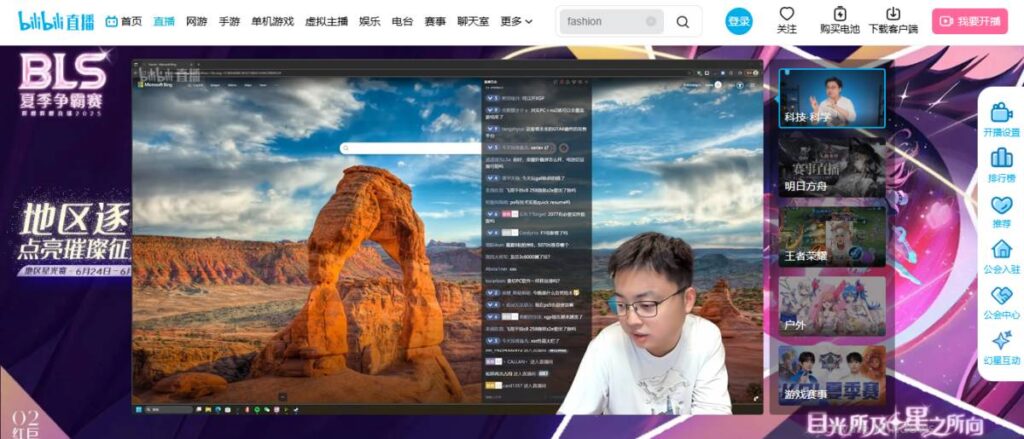Livestreaming has become a cornerstone of digital commerce in China, turning real-time video into a trusted shopping channel. It blends entertainment, influencer engagement, and direct purchasing into one seamless experience.
From luxury brands to agricultural co-ops, businesses across sectors are tapping into Livestream platforms to drive measurable results. Consumers no longer scroll; they watch, ask questions, and buy—all within minutes.
This blog explores the mechanics behind livestream e-commerce in China, the platforms fueling it, how brands and creators adapt, and what it means for the future of global retail.
What Is Livestream E-Commerce?

Image from unlimphotos. Young couple video bloggers streaming live video
Livestream e-commerce is the real-time fusion of video broadcasting and online retail, allowing viewers to watch product demonstrations and purchase directly from the stream. It has grown far beyond a promotional tool in China—it’s now a core sales channel across nearly every major platform.
China’s live streaming market is projected to grow to $33 billion by 2030. This growth reflects more than popularity—it signals a shift in how products are sold, marketed, and trusted.
A Distinct Retail Channel, Not Just Content
Unlike pre-recorded videos or standard e-commerce listings, livestream commerce introduces immediacy and interaction. Hosts—often influencers, sales professionals, or store owners—demonstrate products live, answer questions, and respond to viewer comments. This two-way engagement builds trust, reduces uncertainty, and shortens the path to purchase.
Shoppers don’t just browse—they watch products in use, hear real-time feedback, and get time-limited deals. It’s a fully immersive retail experience, structured around urgency, authenticity, and connection.
Why Livestream Commerce Thrives in China
The rise of livestream e-commerce in China isn’t incidental. It reflects a digital ecosystem designed for instant engagement and frictionless buying. Platforms like Douyin, Taobao, and Kuaishou integrate live video with payment systems like Alipay and WeChat Pay, streamlining transactions within seconds.
China’s mobile-first environment plays a critical role. According to CNNIC’s 2024 report, 99.7% of internet users in China access the web via mobile devices. That mobility drives a culture of passive consumption and spontaneous purchasing—conditions that livestream formats are built to exploit.
In addition, consumer trust in live streamers—especially Key Opinion Leaders (KOLs) and Key Opinion Consumers (KOCs)—often outweighs trust in static product pages or ads. Their recommendations feel human and situational, more like a friend’s tip than a brand pitch. This blend of authenticity and amplification follows many of the same dynamics explained in our guide to What Is Viral Marketing.
Livestream commerce in China is an integrated, high-performing sales model that meets consumers where they already are: entertained, mobile, and ready to transact.
Key Platforms Powering Livestream Shopping
Livestream e-commerce in China thrives across a fragmented landscape, with each platform bringing its mechanics, user base, and purchase behaviors. Understanding these distinctions is critical for any brand aiming to scale within this format.
Taobao Live: Built for Conversion
Taobao Live, launched by Alibaba, was the first major platform to merge live streaming with e-commerce infrastructure at scale. Its seamless product discovery, influencer promotion, and checkout integration set it apart.
Hosts can link products in real time, and viewers can purchase with a single tap—no redirection or disruption. The platform is especially dominant in high-volume categories like beauty, fashion, and home goods.
Douyin: Entertainment-Driven Consumption
Douyin, the Chinese version of TikTok, doesn’t just broadcast products—it sells them through short-form storytelling. Unlike Taobao, Douyin is content-first. The algorithm pushes engaging streams to the right audiences based on viewing behavior, rather than relying on product search.
Its strength lies in entertainment-led discovery. Livestreams on Douyin often start as casual, personality-driven content, gradually integrating product mentions. This format lowers resistance and turns entertainment into sales momentum.
In 2024, over 40% of Douyin’s e-commerce GMV came from shelf-based shopping scenarios. Store-hosted live broadcasts contributed slightly more than 30%, while the remaining GMV came from influencer-led live streams.
Among those, top-tier influencers with over one million followers accounted for approximately 9% of overall GMV, while small—and medium-sized influencers contributed around 21%, maintaining a 3:7 contribution ratio.
Top brands, including Xiaomi, Adidas, Estee Lauder, Apple, and Nike, use Douyin’s official livestreaming channels.
Kuaishou: Deep Penetration in Lower-Tier Markets
Kuaishou’s appeal lies in its tight-knit communities and reach beyond top-tier cities. Unlike the polished style of Douyin or Taobao Live, Kuaishou livestreams often feel raw, conversational, and grounded. Many streamers are small business owners, farmers, or niche product sellers broadcasting directly from their homes or stores.
This authenticity resonates with rural and semi-urban consumers. In 2024, Kuaishou announced that nearly 736 million monthly active users were engaging with livestream commerce. The average session time per livestream surpassed 23 minutes, a clear indicator of deeper viewer engagement.
WeChat and RedNote(RED): Private Traffic and Peer Trust
WeChat and Red do not prioritize discovery through algorithms. Instead, they enable private traffic—repeat audiences cultivated through social interactions, brand accounts, or group chats. Livestream commerce on these platforms relies on sustained relationships and community building.
WeChat’s Mini Programs allow brands to host live streams within their ecosystem, controlling the end-to-end user journey. RedNote, on the other hand, blends influencer storytelling with soft-sell product integration. In 2024, Red’s live stream feature expanded with in-app checkout, boosting conversions in categories like skincare, supplements, and niche fashion.
These platforms don’t win on volume—they win on trust. Their power lies in targeted engagement, making them especially effective for premium brands and high-involvement purchases.
JD Live: Logistics Meets Livestream
JD.com, known for its supply chain and fulfilment strength, entered livestream commerce with JD Live. While not as socially driven as Douyin or Taobao, JD Live focuses on tech-savvy, high-intent shoppers looking for quality and speed.
Unlike platforms that rely on KOLs and MCNs, JD Live often features JD’s own procurement and sales staff as hosts. These insiders bring deep knowledge of product specs, logistics, and pricing, offering credible recommendations and attracting consumer trust.
It’s especially effective for electronics, appliances, and smart home devices. JD leverages its B2C reputation to host expert-led livestreams, where brand representatives explain product specs and respond to real-time questions.
To extend engagement beyond human-hosted sessions, JD has introduced digital avatars—not as replacements but as complementary tools. These AI-driven hosts are deployed after live sessions to capture long-tail traffic during off-peak hours.
JD’s 2024 analytics show that this strategy can increase order conversion rates by up to 30% during off-peak hours, allowing brands to maintain momentum and respond to demand even when livestreamers go offline.
Bilibili: Educated Buyers, Longer Sessions

Bilibili live streaming
Bilibili’s user base is younger and more informed. Unlike other platforms that favor fast-paced selling, Bilibili live streams often emphasize knowledge, niche interest, and community interaction over urgency. Hosts are typically subject matter experts—tech reviewers, animators, hobbyists—who engage deeply with their audiences.
Sessions on Bilibili tend to be longer, allowing for detailed demonstrations and in-depth Q&A. In 2024, the platform reported an average session time of 28 minutes for commerce-related broadcasts.
Commerce livestreaming is a rapidly expanding segment on Bilibili. Top creators generate substantial GMV, with standout examples like fashion uploader @Yingwuli, who reached RMB 50 million in a single live session in 2024.
Bilibili is integrating AI-powered recommendations, in-app purchasing, and multi-device livestream access to scale further. These features aim to personalize commerce and extend reach. With a total 2024 revenue of RMB 26.83 billion, Bilibili proves that creator-led commerce can compete with giants like Douyin and Taobao.
Pinduoduo: Deal-Centric, Social Buying
Pinduoduo’s livestream strategy revolves around bulk deals, time-limited offers, and gamified incentives. It’s less about influencer branding and more about volume-driven purchasing through group buying mechanics.
Livestream commerce on Pinduoduo works best in categories like groceries, household basics, and functional fashion. In 2024, Pinduoduo integrated livestreams with its “team purchase” feature, allowing streamers to drive sales through discounted bundles.
While other platforms push aspirational consumption, Pinduoduo wins through affordability and social motivation.
Beyond Commerce: Long-Form Video Platforms with Brand Reach
Other major players in China’s video space also shape consumer perception and content consumption, though they’re not commerce-first environments.
Tencent Video: Entertainment, Influence, and Audience Reach
Tencent Video is one of China’s largest long-form streaming platforms, with over 800 million users. While it doesn’t focus on livestream shopping, it plays a key role in shaping brand visibility through dramas, variety shows, and sports events.
Brands often sponsor popular series or embed product placements to build awareness before consumers reach purchase decisions on commerce-driven platforms.
Youku (Youku Tudou): Legacy Reach and Licensed Content
Now part of Alibaba Group, Youku offers a Netflix-like experience with professionally produced shows and movies. While not a livestream commerce platform, its influence on middle-tier consumers and brand-safe environment makes it a top-funnel branding space. Cross-promotion with Taobao Live has grown more common, helping bridge entertainment with commerce.
Influencers, Brands, and the Power of Real-Time Engagement

Image from Canva. A woman baking a cake while livestreaming
Livestream e-commerce in China relies heavily on content creators. Their role is to turn product pitches into interactive, real-time experiences. Effectiveness depends on how influencers and brands adapt to live formats while maintaining trust and clarity.
The Strategic Use of KOLs and KOCs
In China’s livestream economy, two influencers dominate:
- Key Opinion Leaders (KOLs)
- Key Opinion Consumers (KOCs)
KOLs are high-profile figures with large audiences. They drive visibility, especially during product launches or seasonal campaigns. Their endorsement can immediately scale awareness and create headline-grabbing sales numbers.
KOCs, on the other hand, are ordinary consumers with smaller but more engaged networks. Their power lies in relatability. A KOC hosting a stream from a kitchen or bedroom often feels more trustworthy than a polished studio production.
How Brands Are Adapting to the Livestream Model
Brands in China no longer treat live streaming as an afterthought. In 2024, over 85% of major consumer-facing companies operating on Douyin or Taobao allocated a dedicated live streaming budget. This budget isn’t limited to hiring influencers—it includes building in-house livestream teams, custom studios, and interactive training for frontline staff.
Some brands prefer to own the experience entirely. For example, skincare companies often use in-house beauty advisors to host daily live streams that mirror one-on-one consultations. Others go hybrid, rotating between internal staff and external KOLs depending on the goal—brand building, product education, or flash sale execution.
The common thread is consistency. A one-off campaign rarely delivers long-term value. Brands that stream daily or weekly build audience expectations, retain attention, and fine-tune their on-air messaging through viewer feedback.
Livestream Commerce as Performance Marketing
The live stream format is no longer limited to brand awareness. With the rise of conversion tracking, multi-stream analytics, and real-time feedback, live streaming has evolved into a form of performance marketing.
Click-through rates, view-to-purchase ratios, and replay interactions are now part of the brand’s daily reporting. Livestreams don’t just sell—they test product-market fit, refine messaging, and generate insights faster than traditional focus groups.
More importantly, livestream data helps brands identify which product angles resonate. If a new mascara sells best when shown under harsh lighting and water exposure, that format becomes part of the following five streams. It’s agile commerce, fine-tuned by data and delivered in real time.
Changing Consumer Behavior and Shopping Habits

Douyin live streaming app.
The rise of livestream commerce in China isn’t simply a technological shift—it reflects a more profound transformation in how people shop, evaluate value, and make decisions.
Livestreaming doesn’t change what consumers want—it changes how and when they act on those desires. The format has created a new buyer: more impulsive, informed, and emotionally engaged.
The Appeal of Real-Time Urgency
Livestream commerce capitalizes on immediacy. Viewers are pulled into a time-sensitive environment where products are introduced, demonstrated, and discounted—all within minutes. Limited stock warnings, countdown timers, and fast-paced hosting create a sense of urgency that traditional online listings can’t replicate.
This urgency isn’t artificial. On platforms like Douyin and Taobao Live, discounts are frequently tied to stream durations or viewer milestones. For many viewers, hesitation means missing out—not just on a deal, but on participation in a shared digital moment.
Trust Through Transparency and Interaction
Consumer skepticism runs high in digital retail. Livestreams counter this by showing products in use, under varied conditions, and responding directly to viewer questions. Hosts squeeze, swipe, pour, or wear products on command—nothing is left to imagination.
This visual proof reduces return rates and strengthens purchase confidence. Trust builds quickly when viewers see a skincare serum absorb into real skin or watch a tech device function live. The spontaneous nature of livestreams also leaves less room for editing or manipulation, adding to the sense of authenticity.
What once required dozens of reviews or multiple customer queries can now be resolved in seconds, live, in front of thousands.
Shopping as Entertainment and Social Ritual
Livestreaming has blurred the boundary between commerce and content. For millions of Chinese consumers, shopping is now a form of evening entertainment. Viewers join streams not just to buy, but to be entertained, informed, or simply feel part of something.
Platforms have leaned into this by adding gamified features, interactive polls, and viewer shoutouts. Hosts play games, quiz audiences, and celebrate milestones in real time. This format keeps viewers engaged, even if they don’t convert immediately.
The outcome is a redefinition of loyalty. It’s no longer tied to price or brand—it’s anchored in the emotional experience of the stream. Over time, this emotional loyalty becomes repeat purchase behavior.
The Future of Livestream E-Commerce in China
Livestream commerce in China has stabilized, and it continues to evolve, shaped by new technologies, changing consumer expectations, and global influence. The next phase will focus less on scale, precision, personalization, and exportability.
The average Chinese user spends about 36 minutes per Livestream show—higher than in the U.S. or Europe—reflecting deep engagement and purchase intent.
AI Hosts and Virtual Influencers
One of the most disruptive changes on the horizon is the rise of AI-generated livestream hosts. In 2024, platforms like JD.com and Baidu began deploying virtual presenters powered by large language models and speech synthesis. These avatars stream around the clock, respond to live queries, and deliver consistent messaging without fatigue or error.
Brands already use virtual hosts to introduce product catalogs, manage customer interactions, and localize content across regional dialects. While human hosts still dominate emotionally resonant categories like fashion and beauty, AI presenters are becoming essential in customer service-heavy verticals like electronics, insurance, and B2B sales.
This shift doesn’t replace human streamers—it complements them by offloading repetitive tasks and increasing scalability.
AR, VR, and Immersive Shopping Environments
Livestreaming is moving beyond the flat screen. With the rollout of AR-enhanced product try-ons and VR storefronts, platforms are bringing immersive shopping closer to the mainstream. Brands are experimenting with 3D showrooms where users can navigate virtual spaces during a live broadcast.
These experiences are compelling for furniture, home décor, and fashion, where spatial context drives decision-making.
As 5G networks expand and consumer hardware improves, immersive livestreams will likely shift from novelty to expectation.
Cross-Border Expansion and Global Adoption
China’s livestream commerce model influences global markets, particularly in Southeast Asia, the Middle East, and Latin America. Platforms like TikTok Shop are already replicating key features—integrated checkout, creator commissions, and time-bound offers—in emerging e-commerce ecosystems.
Chinese platforms are also pushing outbound. Alibaba’s AliExpress and JD Worldwide have begun integrating livestream features for international consumers, supported by multilingual hosts and real-time translation tools.
This global push is not a simple export—it’s an adaptation. Each market requires localized content, cultural nuance, and logistical support. However, the blueprint remains rooted in what China has already proven: people shop when engaged, informed, and emotionally invested in the experience.
What Global Retailers Can Learn from China’s E-Commerce Livestreaming Model

Image from Canva. Florists live-streaming flower sales
China’s livestreaming success isn’t just a regional trend—it’s a blueprint for the future of digital retail. Global brands and platforms can draw several key lessons from how China has embedded livestreaming into the e-commerce funnel:
- Make Shopping Interactive, Not Passive: Chinese platforms excel at turning product showcases into two-way conversations. Live Q&A, viewer polls, and gamified rewards make shopping feel participatory, not transactional. Western retailers can move beyond static listings by using real-time formats to engage customers at the point of consideration.
- Build Trust Through Transparency: Chinese live streams often feature unfiltered product tests—hosts apply skincare, cook with kitchenware, or wear fashion items live. This authenticity shortens the customer decision cycle and reduces returns. Global brands can replicate this by showcasing real-time demos and encouraging unscripted influencer streams.
- Use Influencers Strategically: China distinguishes between Key Opinion Leaders (KOLs) and Key Opinion Consumers (KOCs), each playing a different role. While KOLs generate mass awareness, KOCs drive grassroots trust and niche conversion. Global brands should balance high-reach partnerships with relatable creators who resonate with smaller communities.
- Integrate Livestreams with Seamless Checkout: A major strength in China is frictionless purchasing. Platforms like Taobao and Douyin offer in-stream checkouts that eliminate drop-off points. Western retailers can boost conversion by integrating native checkout within live streams via app ecosystems, embedded payment links, or platform-native shops.
- Treat Livestreaming as Performance Marketing: Live streams are tracked like paid media campaigns in China. Brands measure view-to-purchase ratios, optimize content mid-stream, and adjust promotions based on real-time data. Instead of treating live streams as brand-building events alone, international companies should use them to test messaging, drive direct sales, and gather instant customer insights.
- Stream Consistently—Not Occasionally: Successful Chinese brands livestream daily or weekly, training audiences to tune in regularly. This consistency builds habit, trust, and anticipation. For global retailers, one-off events won’t be enough—success lies in repeat engagement and evolving the stream format over time.
Want to go deeper into how livestreaming connects with data-driven customer engagement? Explore our guide to Social CRM to see how brands align real-time interaction with long-term loyalty.
Supercharge Your Livestream Strategy with Ashley Dudarenok

Ashley Dudarenok on Live streaming in China
Looking to scale your livestream commerce game like China’s top brands? Ashley Dudarenok, founder of Alarice & ChoZan and a trusted advisor to Alibaba, JD, Pinduoduo, and Douyin, blends insider know-how with hands-on tactics to elevate your performance. Recognized globally as a leading China Marketing Expert, she helps brands decode local consumer behavior and apply proven strategies across markets.
Here’s how Ashley’s experience directly ties into the mechanics of livestream e‑commerce.
- Framing Livestreams as Performance Channels: Dudarenok emphasizes that live streaming has moved far beyond brand exposure. It’s now a performance-driven sales tool, measured by click-throughs, conversion rates, and replay engagement. Her perspective supports the growing trend of treating live streams as live A/B tests that optimize real-time product messaging.
- Platform-Specific Expertise: Her guidance often includes how to tailor livestream strategies to each platform:
- On Pinduoduo, she highlights the power of group-buying mechanics during livestreams to drive social engagement and volume.
- On Douyin, she underscores how live content, storefronts, and categories like fresh food form an interconnected ecosystem that fuels conversion through entertainment.
- Trend Intersections: Gen‑Z, Luxury, and Livestreaming: Dudarenok’s research into Gen Z behavior reveals that livestreams are key to luxury discovery in China, especially among younger users who rely on short-form video and peer recommendations. This echoes how platforms like Bilibili foster long-form engagement and trust in niche categories.
- Global Takeaways for Brands: Through her work with international clients, Dudarenok offers frameworks for building in-house livestream capacity, collaborating with KOLs/KOCs, and integrating tools like AI hosts or AR try-ons. Her approach encourages brands to create consistency, learn from live feedback, and adapt strategies by platform and audience.
For organizations looking to inspire their teams and sharpen their strategies with actionable insights, Ashley is also an acclaimed digital marketing speaker who regularly shares cutting-edge perspectives on China’s livestreaming and retail innovation trends.
Book Ashley for your next keynote or workshop
Empower your team with the live-commerce playbook used by China’s most successful brands.
FAQs About Livestreaming in China
-
Can you live stream in China?
Yes, live streaming is legal and widely used in China across multiple platforms, including Douyin, Taobao Live, Kuaishou, and Bilibili. However, streamers and platforms must comply with strict government regulations, such as real-name registration and content moderation guidelines issued by the Cyberspace Administration of China.
-
How many live streamers are there in China?
China has over 15 million active live streamers, including full-time hosts, influencers, brand representatives, and small business owners.
-
What platforms are most used for livestream shopping in China?
The leading platforms include Taobao Live, Douyin, Kuaishou, JD Live, and RedNote (Red). Each serves distinct audiences and product categories. Taobao excels in beauty and fashion, Kuaishou performs well in lower-tier cities, and Douyin dominates entertainment-driven commerce.
-
Who watches livestreams in China?
Livestream audiences in China span across age groups and regions, but Millennials and Gen Z make up the majority. Viewers are mobile-first, socially engaged, and value authenticity. They often watch streams as part of their daily entertainment and shopping habits.
-
How do livestreamers sell products in China?
Livestreamers showcase products in real time, respond to viewer questions, and offer time-sensitive discounts. Many integrate direct links into the stream, allowing users to purchase without leaving the app. This seamless “watch and shop” model shortens the buying journey and boosts conversion rates.
-
Are there regulations for livestreaming in China?
Yes. The Chinese government enforces content and commerce regulations for live streams, including real-name registration, prohibited topics, age restrictions, and e-commerce licensing. Platforms must monitor content and penalize violations, especially those related to health claims, pricing fraud, or counterfeit goods.
-
How long do people watch livestreams in China?
The average viewer in China spends around 36 minutes per livestream session, significantly higher than in Western markets. Engagement times are especially long on platforms like Kuaishou and Bilibili, where streams often include detailed product demos, storytelling, and community interaction.
-
What’s the difference between livestreaming and regular e-commerce?
Livestreaming adds real-time interaction and urgency to the shopping experience. Unlike static product listings, it allows viewers to see products demonstrated live, ask questions, and make instant purchases—often during limited-time promotions or flash sales.
-
Can international brands use livestreaming in China?
Yes. Many global brands—like Nike, L’Oréal, Apple, and Estée Lauder—actively participate in China’s livestream ecosystem. They collaborate with local KOLs or set up in-house streaming teams. Success depends on platform localization, audience insight, and compliance with Chinese regulations.
-
What technology powers livestream shopping in China?
Chinese platforms integrate AI recommendation engines, real-time data tracking, in-stream checkout, and increasingly, virtual influencers or AI-generated hosts. These tools personalize the viewer experience and help brands optimize conversion during live events.
-
How does livestreaming in China compare to the West?
Livestream commerce in China is far more advanced. While Western markets treat live streams as promotional tools, they are full-funnel sales channels in China. Chinese platforms offer native checkout, influencer-led shopping, and deeper integration between content, community, and commerce.

